Meeting environmental standards governing the sulfur content of oil-based fuels hinges around the optimization of hydrotreatment processes (HDT), involving, in particular, the development of more efficient catalysts. Catalyst efficiency depends on the activation of catalytic sites, a step produced by a sulfurization treatment, before use, within an industrial reactor.
The characterization of this phenomenon in the laboratory is generally carried out via a gas phase treatmenta. Not representative of liquid phaseb industrial treatment, it does not always make it possible to correlate the physicochemical characteristics of the sulfur phase formed with catalytic performances in real operating conditions.
In order to study the in situ sulfurization mechanism of HDT catalysts in industrial conditions, a Quick-XASc analysis unit making it possible to reproduce such an operating environment was developed at IFPEN (figure), and then installed at the SOLEILd synchroton’s ROCK beamline to characterize the structure of the active phases formed during activation.
Direct observation during the liquid phase sulfurization process helped to explain the changes in the active phase and their effect on catalytic performances.
Industrial activation conditions lead to the initial formation of well-dispersed and depolymerizede oxide species on the alumina surface. With the massive release of H2S at 225°C, the nucleation ofoxysulfide occurs almost instantaneously, before that of MoSx species.

This mechanism may be the source of the slight morphological differences observed under the microscope on the final MoS2 phase, i.e., small-sized and better dispersed slabs leading to improved catalyst activity.
a - H2S/H2, 1 bar
b - Diesel/H2 /sulfurizing agent, under pressure (30 bar) and at a temperature of 350°C
c - XAS = X-ray Absorption Spectroscopy
d - French synchrotron radiation center, a major multidisciplinary instrument and research laboratory
e - Thus converted into simpler species
(1) C. Lesage, E. Devers, C. Legens, G. Fernandes, O. Roudenko, V. Briois. Catalysis Today, Elsevier, 2019, 336, pp.63-73.
https://doi.org/10.1016/j.cattod.2019.01.081
Scientific contact: christele.legens@ifpen.fr





